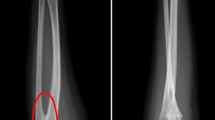Abstract
A 47,XXY karyotype was found in a 6-year-old girl. The patient had female external genitalia, clitoromegaly, remnants of the ductus mesonephricus, uterus, and gonads in the labia majora which were determined to be testes by histology. Cytogenetic and DNA analyses suggest that the Y chromosome had a normal structure and that both X chromosomes were of maternal origin. The unusual clinical findings in the patient are discussed.
Similar content being viewed by others
References
Arnemann J, Cooke HJ, Jakubiczka S, Schmidtke J (1985) Human Y-chromosome derived cloned DNA sequences (8th International Workshop on Human Gene Mapping). Cytogenet Cell Genet 40:571
Bartsch-Sandhoff M, Stephan L, Röhrborn G Pawlowitzki IH, Scholz W (1976) Ein Fall von testiculärer Feminisierung mit dem Karyotyp 47,XXY. Hum Genet 31:59–65
Berta P, Hawkins JR, Sinclair AH, Taylor A, Griffiths B, Goodfellow PN, Fellous M (1990) Genetic evidence equating SRY and the testis determining factor. Nature 348:448–450
Bishop C, Guellaen G, Geldwerth D, Fellous M, Weissenbach J (1984) Extensive sequence homologies between Y and other chromosomes. J Mol Biol 173:403–417
Brown CJ, Goss SJ, Lubahn DB, Joseph DR, Wilson EM, French FS, Willard HF (1989) Androgen receptor locus on the human X chromosome: regional localization to Xq11–12 and description of a DNA polymorphism. Am J Hum Genet 44:264–269
Caspersson T, Zech L, Johannson C, Modest EJ (1970) Identification of human chromosomes by DNA-binding fluorescent agents. Chromosoma 30:215–277
Cooke H (1976) Repeated sequence specific to human males. Nature 262:182–186
Feinberg AP, Vogelstein B (1984) A technique for radiolabeling DNA restriction endonuclease fragments to high specific activity. Anal Biochem 137:266–267
Fraser NJ, Boyd Y, Brownlee GG, Craig IW (1987) Multi-allelic RFLP for M27β, an anonymous single copy genomic clone at Xp11.3-Xcen (HGM provisional no. DXS255). Nucleic Acids Res 15:9616
Geldwerth D, Bishop C, Guellaen G, Koenig M, Vergnaud G, Mandel JL, Weissenbach J (1985) Extensive DNA sequence homologies between the human Y and the long arm of the X chromosome. EMBO J 4:1739–1743
Gerli M, Migliorini G, Bocchini V, Venti G, Ferrarese R, Donti E, Rosi G (1979) A case of complete testicular feminization and 47,XXY karyotype. J Med Genet 16:480–483
German J, Vesell M (1966) Testicular feminization in monozygotic twins with 47 chromosomes (XXY). Ann Genet 9:5–8
German J, Simpson JL, Morillo-Cucci G, Passarge E, Demayo AP (1973) Testicular feminization and inguinal hernia. Lancet I:891
Guellaen G, Casanova M, Bishop C, Geldwerth D, Andre G, Fellous M, Weissenbach J (1984) Human XX males with single-copy DNA fragments. Nature 307:172–173
Hassold T, Jacobs PA (1984) Trisomy in man. Annu Rev Genet 18:69–97
Hawkins JR, Taylor A, Berta P, Levilliers J, van der Auwera B, Goodfellow PN (1992) Mutational analysis of SRY: nonsense and missense mutations in XY sex reversal. Hum Genet 88:471–474
Hook EB, Hamerton JL (1977) The frequency of chromosome abnormalities detected in consecutive newborn studies. In: Hook EB, Porter IH (eds) Population cytogenetics. Academic Press, New York, pp 63–79
Jacobs PA, Strong JA (1959) A case of human intersexuality having a possible XXY sex determining mechanism. Nature 183:302–303
Jacobs PA, Hassold TJ, Whittington E, Butler G, Collyer S, Keston M, Lee M (1988) Klinefelter's syndrome: an analysis of the origin of the additional sex chromosome using molecular probes. Ann Hum Genet 52:93–109
Jagiello G, Atwell JD (1962) Prevalence of testicular feminization. Lancet 1:329
Jäger RJ, Anvret M, Hall K, Scherer G (1990) A human XY female with a frameshift mutation in SRY, a candidate testis determining gene. Nature 348:452–454
Mahtani MM, Willard HF (1988) A primary genetic map of the pericentromeric region of the human X chromosome. Genomics 2:294–301
Morris JM (1953) The syndrome of testicular feminization in male pseudohermaphrodites. Am J Obstet Gynecol 65:1192–1211
Müller U, Donion TA, Kunkel SM, Lalande M, Latt SA (1987) Y-190, a DNA probe for the sensitive detection of Y-derived marker chromosomes and mosaicism. Hum Genet 75:109–113
Müller U, Schneider NR, Marks JF, Kupke KG, Wilson GN (1990) Maternal meiosis II nondisjunction in a case of 47,XXY testicular feminization. Hum Genet 84:289–292
Page DC, Harper ME, Love J, Botstein D (1984) Occurrence of a transposition from the X-chromosome long arm to the Y-chromosome short arm during human evolution. Nature 311:119–123
Pearson PL, Kidd KK, Willard HF (1987) Human gene mapping by recombinant DNA techniques. (9th International Workshop on Human Gene Mapping) Cytogenet Cell Genet 46:390–566
Pergament E, Heimler A, Snap P (1973) Testicular feminization and inguinal hernia. Lancet II:740–741
Schinzel A (1984) Catalogue of unbalanced chromosome aberrations in man. de Gruyter, New York Berlin, pp 790–793
Schmid M, Guttenbach M, Nanda I, Studer R, Epplen JT (1990) Organization of DYZ2 repetitive DNA on the human Y chromosome. Genomics 6:212–218
Schweizer D, Ambros P, Andrle M (1978) Modification of DAPI banding on human chromosomes by prestaining with a DNA binding oligopeptide antibiotic, distamycin A. Exp Cell Res 111:327–332
Sinclair HA, Berta P, Palmer MS, Hawkins JR, Griffiths B, Smith M, Foster J, Frischauf A-M, Lovell-Badge R, Goodfellow PN (1990) A gene from the human sex-determining region encodes a protein with homology to a conserved DNA-binding motif. Nature 346:240–244
Sumner AT (1972) A simple technique for demonstrating centromeric heterochromatin. Exp Cell Res 75:304–306
Willard HF, Smith KD, Sutherland J (1983) Isolation and characterization of a major tandem repeat family from the human X chromosome. Nucleic Acids Res 11:2017–2033
Yang TP, Hansen SK, Oishi KK, Ryder OA, Hamkalo BA (1982) Characterization of a cloned repetitive DNA sequence concentrated on the human X chromosome. Proc Natl Acad Sci USA 79:6593–6597
Author information
Authors and Affiliations
Additional information
Dedicated to Professor Ulrich Wolf on the occasion of his 60th birthday
Rights and permissions
About this article
Cite this article
Schmid, M., Guttenbach, M., Enders, H. et al. A 47,XXY female with unusual genitalia. Hum Genet 90, 346–349 (1992). https://doi.org/10.1007/BF00220456
Received:
Revised:
Issue Date:
DOI: https://doi.org/10.1007/BF00220456




